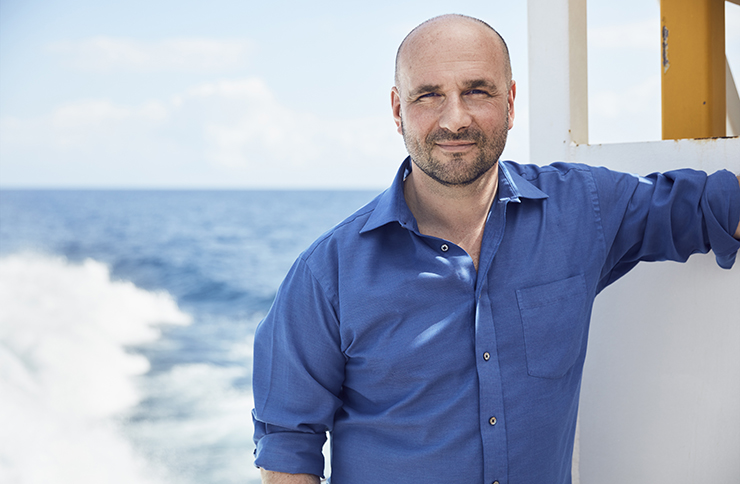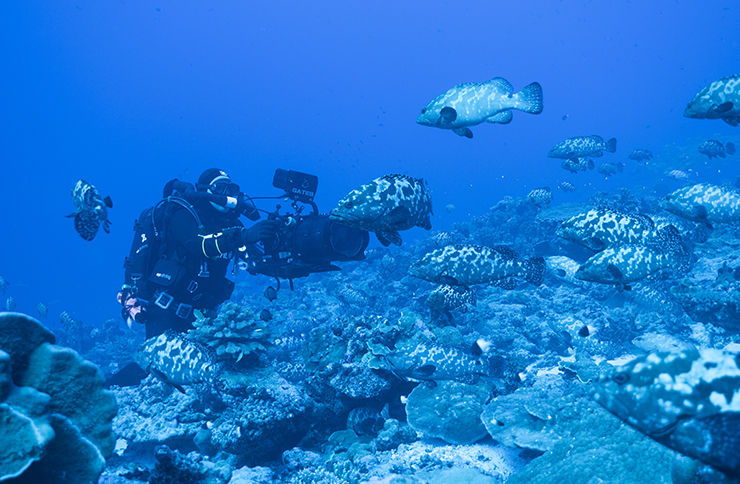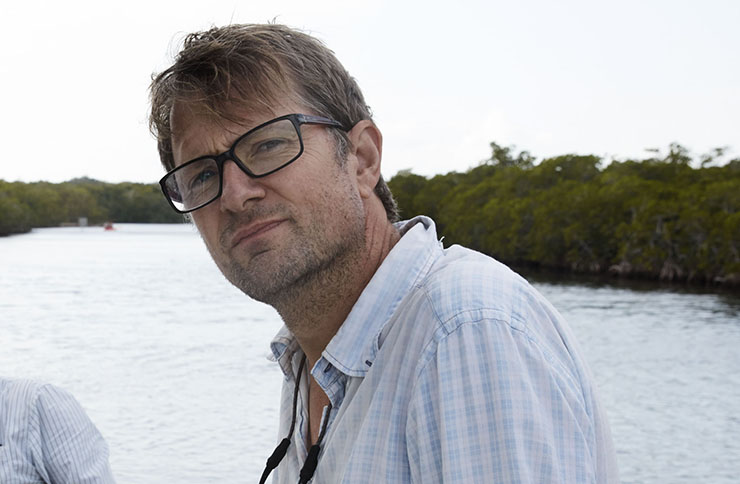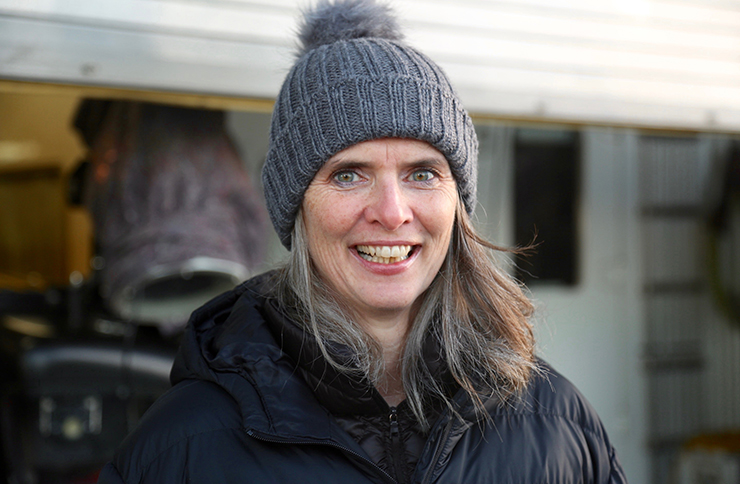EXCLUSIVE: Inside the Making of Planet Earth: Blue Planet II with the show’s producers
Our Earth is a trippy place and the creators of the multi Emmy-winning series Blue Planet II have proven that none is more trippy than the ocean’s floor. The second instalment of the the BBC Worldwide series is the number one watched show in the UK is set to premiere in the US this Saturday (January 20) on BBC AMERICA, AMC, IFC, WE tv and SundanceTV. Executive producer James Honeyborne, and producers Mark Brownlow and Orla Doherty, sat down with Mandy News to discuss what goes into producing such a show, some of their more harrowing experiences underwater, the intense research and safety precautions that go into a shoot, the impact of global warming on the sea, bird-catching and sex-changing fish (yes!) plus insight into identifying if you are the type of person who would risk life and limb to make such a show possible.
First, we have to ask about the esteemed Sir David Attenborough and what it was like working with him both times?
James Honeyborne: It’s such an honour to work with the world’s best communicator of wildlife filmmaking. With 50 years of experience and an encyclopaedic knowledge of the subject; he’s such an amazing communicator. It’s a privilege to work with him.
How many cameras did you use overall?
Mark Brownlow: We use a range of camera technology. We built around lenses, housings, to give the audience a fresh physicalisation of the ocean – from a MegaDome, which is a 24-inch domed camera port to see, in-focus, both above and beneath the water, so you can see a walrus mum and her calf in focus on top of an iceberg and then see the iceberg beneath.
So it’s lenses like that and low-light camera technology so we could film in pitch darkness as mobular (devil fish) swoop into these clouds of plankton that light up in bioluminescence when they are disturbed, to motorised cameras with multi-sensors including a reclusive recording that we could place on the backs of orcar as they tear through these massive shoals of herrings to give the audience an experience of riding on the back of a giant.
Camera technology was instrumental in telling these stories.
How long was the shooting process?
Brownlow: Four years. Six thousand hours underwater filming. One hundred twenty-five expeditions. It’s a massive undertaking.
Honeyborne: We filmed in every continent, 39 countries. It’s truly global and you are right, it’s the most watched show in the UK in 2017. It’s the critics’ choice but it has also come out in other countries. It’s been big in China for example, so we are starting to see a global conversation happening.
Can you talk a little bit more about how you started prepping?
Honeyborne: It was four years in the making. The first year was research because it’s all about collaboration. Collaboration is scientific with ocean explorers, with people who are out at sea who can tell us what is going on. We did about a year of that, really honed our stories before we went out filming.
So it takes a year to research, is there anything even before that?
Honeyborne: It took a year to research it and then over the next three years we would get to meet with them, work with them, maybe come back every season, so a lot of our relationships with the scientific community spanned almost five years.
How do you plan what is going to go in?
Brownlow: You have to write it after a year’s planning and research, you think you’ve identified the best stories and a compelling story for that particular episode but of course when you go out and film it, you don’t always get exactly what you thought you were going to get and you may fail completely.
Then you realise, "Oh my God, got a hole in my story and a hole in my budget, got to rethink everything." So you have to make a very fluid narrative and react to the opportunities as well.
Did you ever go over budget?
Brownlow: We all started off without a grey hair and then it’s a continuous, reactive process where you are making sound judgements to find the very best story.
Honeyborne: It’s often amazing to us how things do go awry. You have to put so much planning and preparation into it not only because the animals may not show up but because the ocean is inherently dangerous. So you have to be so rigorous in your prep that by the time you get there, it all starts working. More often than not, we do get what we want.
How much of it is serendipitous?
Orla Doherty: We work so hard to do our research and put ourselves in the right place at the right time to film whatever we are after, but yeah there are things. In the deep, for sure, because we are working so much at the edge of what we know. So yeah, in the deep more than any other. I’d say that every film has got something they didn’t plan on filming. The ocean is changing so much.
Brownlow: The way we found the giant fish that leaps out and plucks the bird out of the air, we heard about it through a fisherman based out of South Africa who reported it. It took about six months of digging to find the individual, then we found out it wasn’t out of South Africa at all, it was in the Indian Ocean out of the Seychelles and there wasn’t a single photograph or scientific report and so we really had to take a leap of faith and launch this expedition which involved hiring seaplanes and to get out and back and beyond, to film this unique bit of behaviour.
What are some of the things you had to do to keep everyone safe?
Honeyborne: We had a sub being pushed around by some big sharks and they didn’t want the sub there and they started pushing it around and you realise that there are greater forces down there than you. But our framing is always to try to mitigate these routes and always to be responsive to the animals and their needs and you always have to know when to back off or pull out.
The weather plays a huge impact. There are always all sorts of physical things that happen in the water that you don’t think about on land, whether it’s the tides or the visibility changing all the time. It’s all about timing.
 BBC
BBC
Blue Planet II producer James Honeyborne
Orla, please tell us more about the episodes you produced and being underwater for those two episodes.
Doherty: Because I was making a deep episode, that meant going into the deep ocean which is not something I had ever done before or anyone on my team. Every time we got into the submersibles and went down there, we would have an idea of what we hoped we might find but you’re going into the unknown and going to Antarctica, we really were going where no humans had gone before.
It was an incredible privilege to be exploring these worlds and at the same time it was incredibly stressful. I never knew when we were going to get an amazing story. Luckily we got a whole ton of them and the deep episode is this journey through this crazy world with these crazy animals doing crazy things, so it paid off.
We had things go wrong quite a lot and there were enough times for us to have some exciting times. We had a leak in Antarctica and because the water is so cold, one of the seals on the sub wasn’t working. Water started to come in but we were deep and it was exciting trying to find where the water’s coming from. The pilot managed to solve the problem and it was all fine but that’s not what you want to see.
I just feel like if you've found the part of the natural world that you love, then just be in it, do what you can to learn about it and keep putting yourself in a place where you might actually get to communicate about it because that’s the point. To really share this world that we’ve got to know so well.
Honeyborne: Probably the unifying feature of everyone on our team is the passion of the subject. You have to have a passion to tell stories and communicate stories about a natural world. That’s kind of the base level; how it feels in your heart.
 BBC
BBC
An underwater cameraman captures aquatic life for Blue Planet II
As children, were any of you fascinated with nature and how the world works?
Honeyborne: My grandparents lived on an island on the English channel and I would spend all my summers there with my head in the rock pools. It was like, to me, treasure; all these different anatomies and crabs and fish and these rock pools and what looked like little underwater forests with the seaweed and all happening.
How do any of you feel about global warming?
Brownlow: We do see a lot of change happening in the oceans, for example, we see the temperatures rising. We’ve had bleaching events in the great Barrier Reef in Australia. We’ve had two consecutive events in 2016-17 and that’s unprecedented. First time it’s ever happened. You are seeing change but you are also seeing huge amounts of plastic pollution, for example.
Noise pollution in every part of the ocean, even the deepest ocean trenches. So the oceans are changing and you cannot tell a contemporary portrait without including some of these issues.
 BBC
BBC
Blue Planet II producer Mark Brownlow
You mentioned noise pollution?
Honeyborne: Yeah, surprising. We don’t think about it but actually the amount of noise pollution we make is huge and it travels so far underwater. It has a very big impact on a number of creatures.
Brownlow: Yeah, so some scientists wanted to record sound near the deepest part of the ocean.
Doherty: Yeah and the scientists that were doing that work, they did take recordings but what they were hearing was the noise of shipping taps. This is seven miles deep and they were just hearing us, hearing our activity way down at the bottom of the ocean and it was just incredible.
Honeyborne: I think it’s important to say that we didn’t have an environmental agenda. We wanted to tell the story of incredible and inspiring animal characters that live beneath the waves but if you are going to represent their world then you’re also going to have to feature some of these big issues because they’re there.
I figured you would experience some of that, doing what you were doing.
Brownlow: We did. We came across turtles being strangled by pieces of plastic or baby sperm whales playing with plastic buckets. You cannot avoid the human impact in today’s oceans, you just witness it.
 BBC
BBC
Blue Planet II producer Orla Doherty
Who wants to talk about the sex-changing fish?
Brownlow: So gender transforming fish, surprisingly common but not often as dramatic as it is in this species of Japanese sheepshead, Kobudai fish. They live off the Japanese islands.
When a female gets big enough, and if there aren’t too many dominant males around, she might choose to change into a male because, by doing so, you can have many more offspring and that’s the opportunity she has. It’s triggered by social cues, by the number of other males around and by her own size and development and her stage in life.
Some fish go from male to female. Some fish are even more gender fluid and go between the two genders multiple times in their lives.
Honeyborne: It’s far more commonplace than we ever appreciated.
Why?
Brownlow: There are selective advantages on changing sex depending on the stage you are in your reproductive cycle. So if you are a male corp, you tend to have a lot more offspring because you fertilise a lot more of the partners.
Did you know that the three of you would have chemistry?
Brownlow: Well, when you spend months at sea in small boats, you lose inhibitions (laughs).
Comments

Chris Lambert
18-01-2018
What is the best route for getting into a show like this a cameraman?


Advice for Actors: Spotting Mental Distress
Charlotte Armitage, Film & TV Industry Psychologist and Managing Director of YAFTA and YAFTA Talent Agency,&nb...

An interview with Emmy nominated cinematographer Arlene Nelson
Mandy News talks to Cinematographer Arlene Nelson, whose camera work has led to collaborations with iconic dir...

"Don’t be shy to reach out to anyone you really want to connect with" editor Christopher S Capp
Mandy News talks to Film Editor Christopher S. Capp who is known for his work on The Hunge...

"If you keep at it and don’t give up you will get where you want to go" Sean Gascoine
Sean Gascoine is working for one of the biggest talent agencies in the world, United Agents. He started his ca...
Popular

Advice for Actors: Comparisons
In this month's advice column, film & TV industry Psychologist, Charlotte Armitage talks about comparing your...

Advice for Actors: The value of Networking
In this month's advice column, film & TV industry Psychologist, Charlotte Armitage talks about the importance...

Advice for Actors: Therapy
In this month's advice column, film & TV industry Psychologist, Charlotte Armitage talks about the importance...

Wrapal Acquired by Set Scouter, Creating Largest Locations Company in North America
Wrapal, the film industry’s first startup connecting filmmakers to film locations, has been acquired...

An Interview with Three Billboards Outside Ebbing, Missouri Director, Martin McDonagh
Oscar-nominated writer-director Martin McDonagh has found big-screen success with the pitch black humor of In...

An Interview with Dave Fennoy, voice of Lee Everett in 'The Walking Dead' Game
Dave Fennoy is an award winning voice actor whose best known work among others is the role of Lee Everett...

"Get on set and wear those hats, try those things" cinematographer Pietro Villani
Los Angeles based cinematographer Pietro Villani has been shooting movies, documentaries, shorts and commercia...

An Interview with Brennen Sheridan Dicker, Head of Creative Media Industries Institute
Brennen Sheridan Dicker is the Head of Creative Media Industries Institute (CMII) at Georgia State U...

